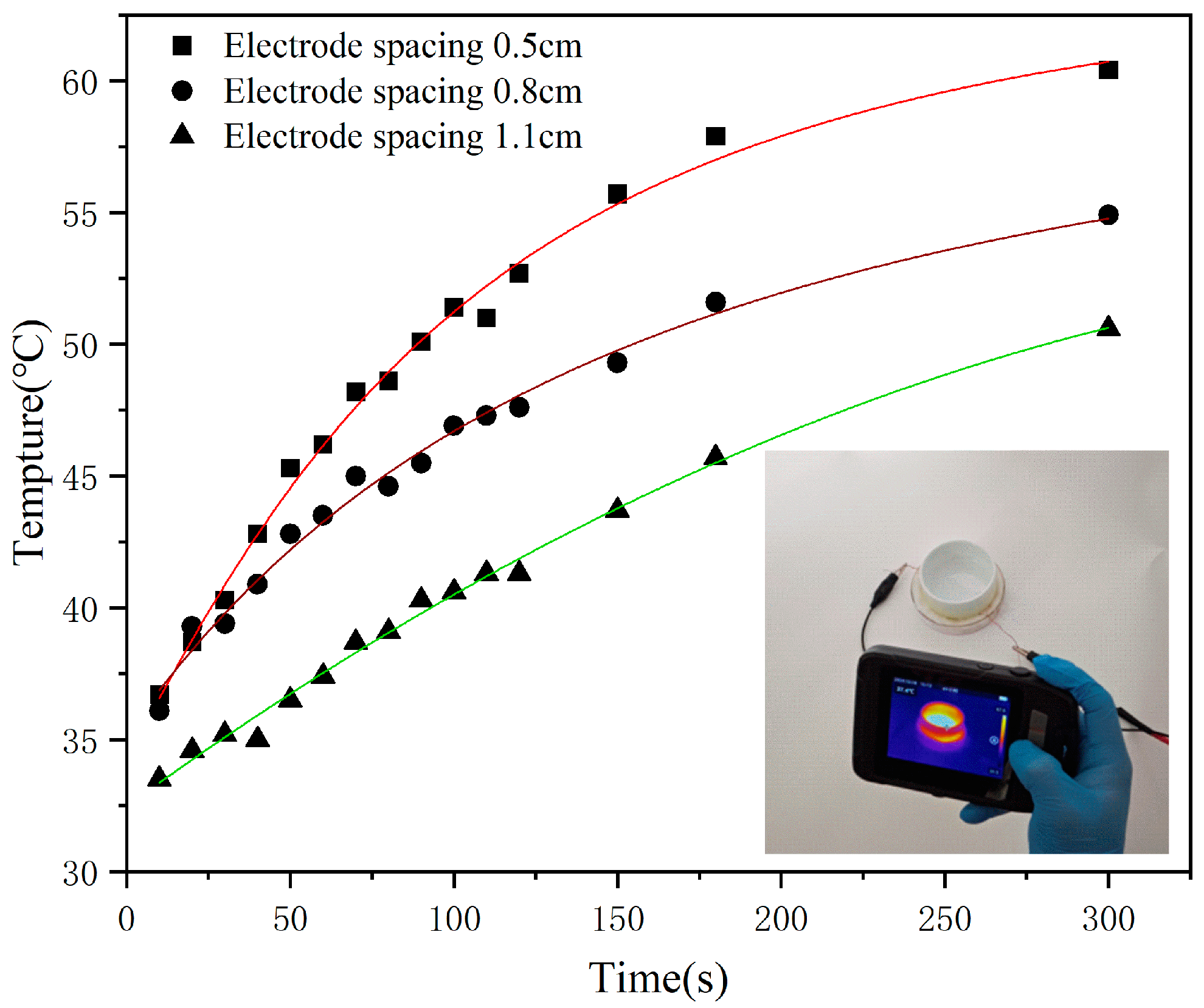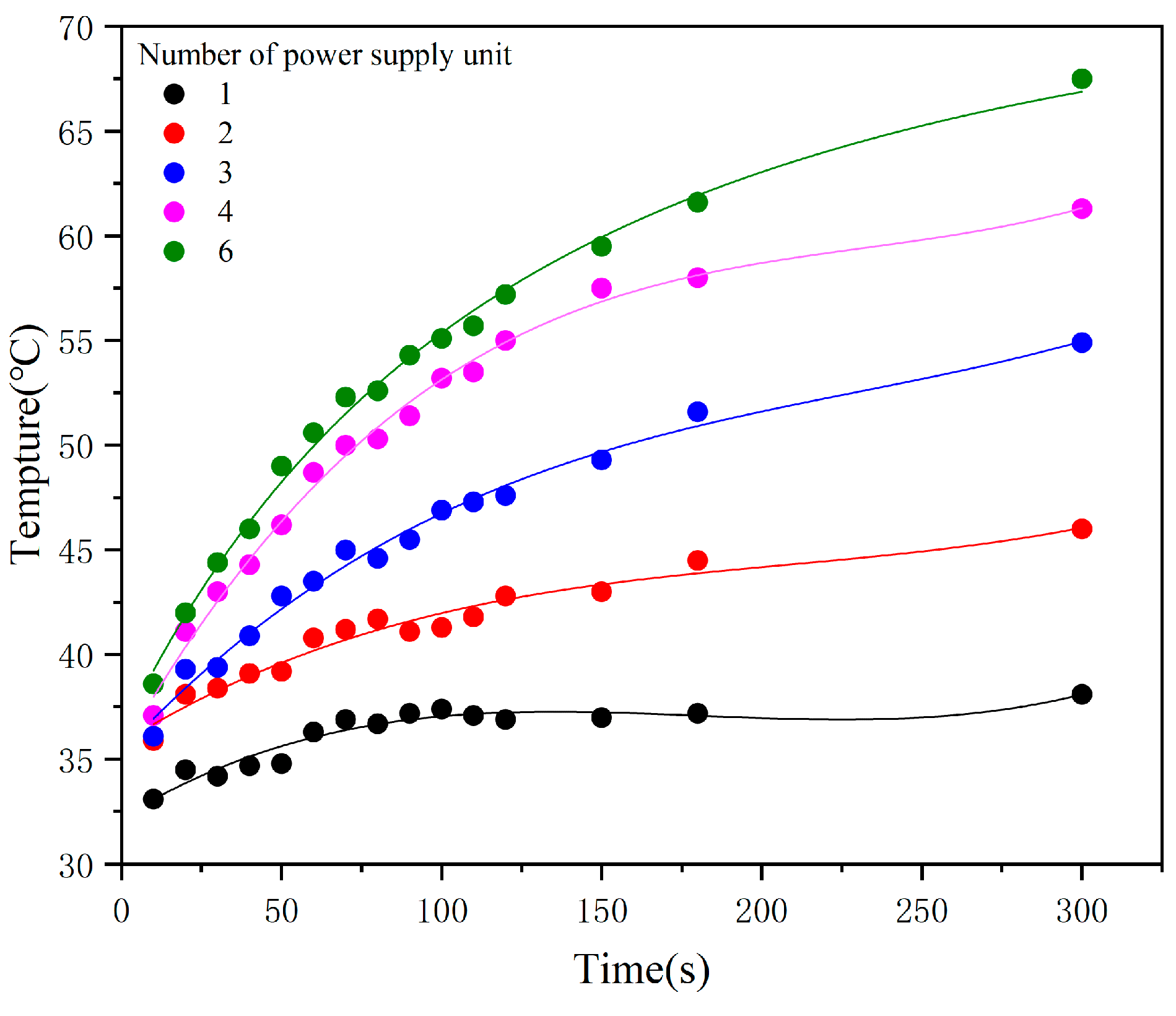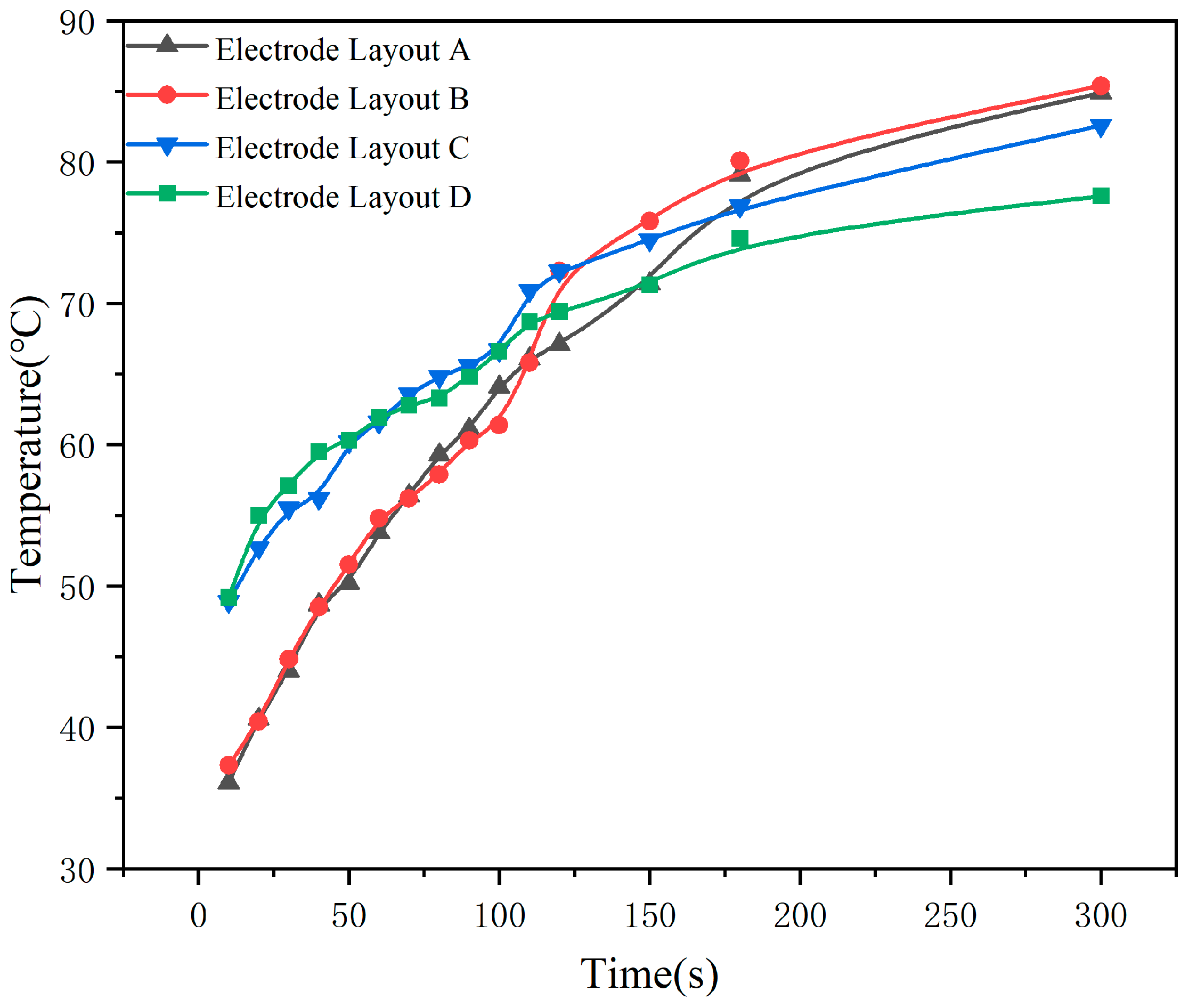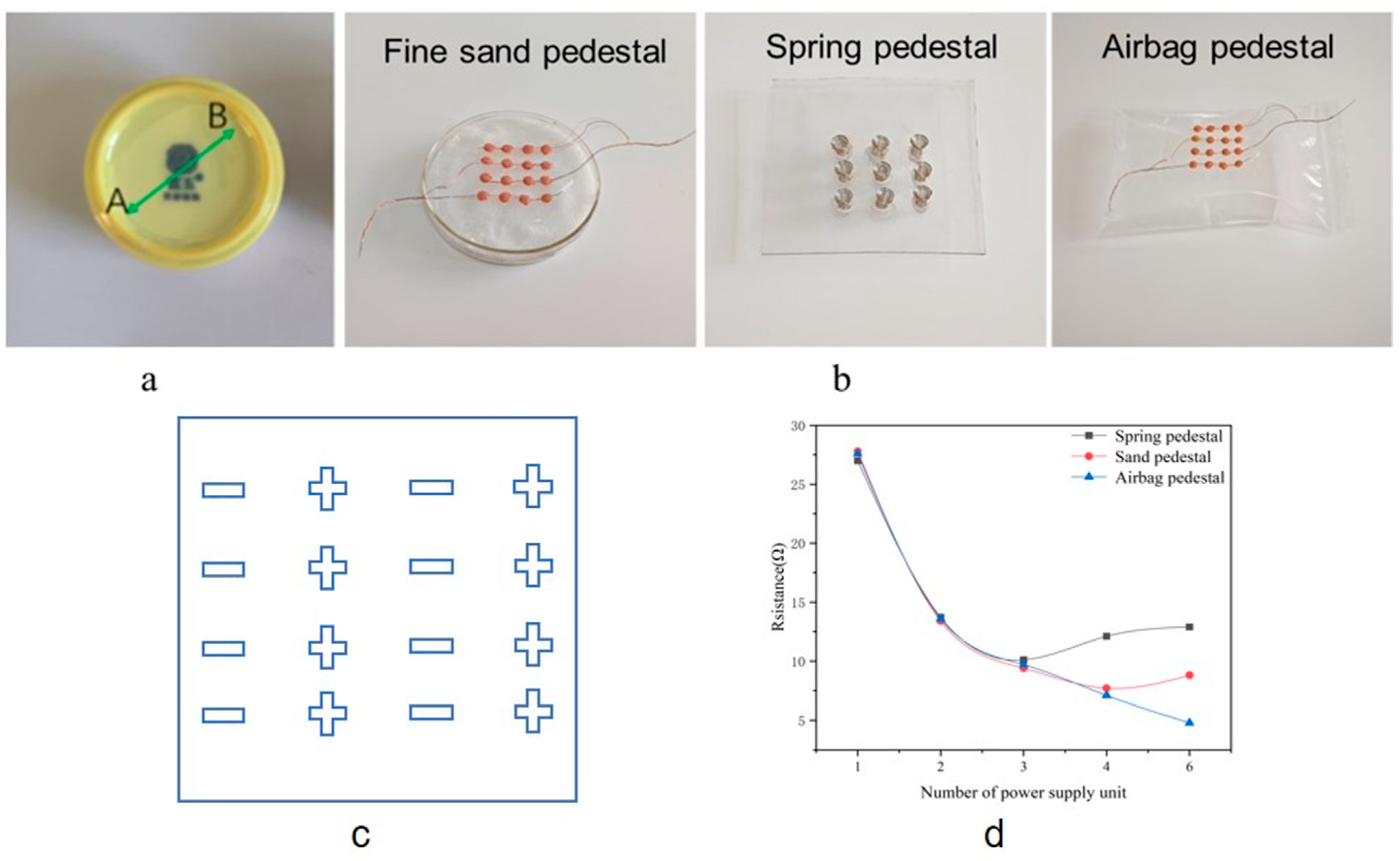Research on the Heating of Multi-Power Supply Units for Large-Area and Curved-Surface Transparent Electrothermal Films
Abstract
:1. Introduce
2. Materials and Methods
2.1. Materials
2.2. Experimental Method
2.3. Characterization
3. Results and Discussion
3.1. Equivalent Resistance Versus Voltage
3.2. Influence of Electrode Spacing on Heating Efficiency
3.3. Relationship Between Power Supply Units and Heating Efficiency
3.4. Influence of Multi-Power Supply Layout on Temperature Uniformity
3.5. Heating Curved-Surface Electrothermal Ceramic Teacups
4. Conclusions
Supplementary Materials
Author Contributions
Funding
Institutional Review Board Statement
Informed Consent Statement
Data Availability Statement
Conflicts of Interest
References
- Xie, S.; Tu, L.; Han, Y.; Huang, L.; Kang, K.; Lao, K.U.; Poddar, P.; Park, C.; Muller, D.A.; DiStasio, R.A.; et al. Coherent, Atomically Thin Transition-Metal Dichalcogenide Superlattices with Engineered Strain. Science 2018, 359, 1131–1136. [Google Scholar] [CrossRef] [PubMed]
- Li, M.-Y.; Shi, Y.; Cheng, C.-C.; Lu, L.-S.; Lin, Y.-C.; Tang, H.-L.; Tsai, M.-L.; Chu, C.-W.; Wei, K.-H.; He, J.-H.; et al. Epitaxial Growth of a Monolayer WSe2-MoS2 Lateral p-n Junction with an Atomically Sharp Interface. Science 2015, 349, 524–528. [Google Scholar] [CrossRef] [PubMed]
- Duan, X.; Wang, C.; Shaw, J.C.; Cheng, R.; Chen, Y.; Li, H.; Wu, X.; Tang, Y.; Zhang, Q.; Pan, A.; et al. Lateral Epitaxial Growth of Two-Dimensional Layered Semiconductor Heterojunctions. Nat. Nanotechnol. 2014, 9, 1024–1030. [Google Scholar] [CrossRef] [PubMed]
- Liu, Y.; Duan, X.; Shin, H.-J.; Park, S.; Huang, Y.; Duan, X. Promises and Prospects of Two-Dimensional Transistors. Nature 2021, 591, 43–53. [Google Scholar] [CrossRef]
- Mehrali, M.; Bagherifard, S.; Akbari, M.; Thakur, A.; Mirani, B.; Mehrali, M.; Hasany, M.; Orive, G.; Das, P.; Emneus, J.; et al. Blending Electronics with the Human Body: A Pathway toward a Cybernetic Future. Adv. Sci. 2018, 5, 1700931. [Google Scholar] [CrossRef]
- Ling, Y.; An, T.; Yap, L.W.; Zhu, B.; Gong, S.; Cheng, W. Disruptive, Soft, Wearable Sensors. Adv. Mater. 2020, 32, 1904664. [Google Scholar] [CrossRef]
- Abiri, P.; Luo, Y.; Huang, Z.-Y.; Cui, Q.; Duarte-Vogel, S.; Roustaei, M.; Chang, C.-C.; Xiao, X.; Packard, R.; Cavallero, S.; et al. 3-Dimensional Electrical Impedance Spectroscopy for in Situ Endoluminal Mapping of Metabolically Active Plaques. Sens. Actuators B Chem. 2022, 354, 131152. [Google Scholar] [CrossRef]
- Wang, S.; Nie, Y.; Zhu, H.; Xu, Y.; Cao, S.; Zhang, J.; Li, Y.; Wang, J.; Ning, X.; Kong, D. Intrinsically Stretchable Electronics with Ultrahigh Deformability to Monitor Dynamically Moving Organs. Sci. Adv. 2022, 8, eabl5511. [Google Scholar] [CrossRef]
- Liu, W.; Hu, Y.; Chen, Y.; Hu, Z.; Zhou, K.; Min, Z.; Liu, H.; Zhan, L.; Dai, Y. Improvement of Electrical Properties of Silver Nanowires Transparent Conductive by Metal Oxide Nanoparticles Modification. Coatings 2022, 12, 1816. [Google Scholar] [CrossRef]
- Hu, Y.; Wu, W. Investigation of Silver Nanowire Transparent Heated Films Possessing the Application Scenarios for Electrothermal Ceramics. Coatings 2023, 13, 607. [Google Scholar] [CrossRef]
- Zhou, K.; Hu, Y.; Chen, Y.; Hu, Z.; Hu, Y.; Liu, W.; Min, Z. Surface Modification of Silver Nanowire Transparent Conductive Films by Metal Oxide Nanoparticles and the Application of Electric Ceramic Teacup. Ceram. Int. 2023, 49, 14530–14537. [Google Scholar] [CrossRef]
- Zhang, Y.; Yang, F.; Liu, H.; Zhang, Y.; Hu, Z.; Liu, J. Transparent Heaters Based on CVD Grown Few-Layer Graphene. J. Mater. Sci. Mater. Electron. 2022, 33, 3586–3594. [Google Scholar] [CrossRef]
- Zhao, Y.; Niu, M.; Yang, F.; Jia, Y.; Cheng, Y. Ultrafast electro-thermal responsive heating film fabricated from graphene modified conductive materials. Eng. Sci. 2019, 8, 33–38. [Google Scholar] [CrossRef]
- He, R.; Fang, D.; Wang, P.; Zhang, X.; Zhang, R. Electrical Properties of ZrB2–SiC Ceramics with Potential for Heating Element Applications. Ceram. Int. 2014, 40, 9549–9553. [Google Scholar] [CrossRef]
- Han, J.; Hu, P.; Zhang, X.; Meng, S.; Han, W. Oxidation-Resistant ZrB2–SiC Composites at 2200 °C. Compos. Sci. Technol. 2008, 68, 799–806. [Google Scholar] [CrossRef]
- Sui, D.; Huang, Y.; Huang, L.; Liang, J.; Ma, Y.; Chen, Y. Flexible and Transparent Electrothermal Film Heaters Based on Graphene Materials. Small 2011, 7, 3186–3192. [Google Scholar] [CrossRef]
- Ma, Z.; Kang, S.; Ma, J.; Shao, L.; Wei, A.; Liang, C.; Gu, J.; Yang, B.; Dong, D.; Wei, L.; et al. High-Performance and Rapid-Response Electrical Heaters Based on Ultraflexible, Heat-Resistant, and Mechanically Strong Aramid Nanofiber/Ag Nanowire Nanocomposite Papers. ACS Nano 2019, 13, 7578–7590. [Google Scholar] [CrossRef]
- Sannicolo, T.; Lagrange, M.; Cabos, A.; Celle, C.; Simonato, J.; Bellet, D. Metallic Nanowire-Based Transparent Electrodes for Next Generation Flexible Devices: A Review. Small 2016, 12, 6052–6075. [Google Scholar] [CrossRef]
- Pavlov, D.V.; Il’yaschenko, V.M.; Bozhok, A.V.; Banniy, D.E.; Kuchmizhak, A.A.; Shevlyagin, A.V. Transparent Microheater Enabled by Laser Perforation of the Thin CaSi2 Film. Bull. Russ. Acad. Sci. Phys. 2024, 88, S418–S422. [Google Scholar] [CrossRef]
- Yu, S.; Liu, X.; Dong, H.; Wang, X.; Li, L. Flexible High-Performance SnO2/AgNWs Bilayer Transparent Conductors for Flexible Transparent Heater Applications. Ceram. Int. 2021, 47, 20379–20386. [Google Scholar] [CrossRef]
- Zheng, B.; Zhu, Q.; Zhao, Y. Fabrication of High-Quality Silver Nanowire Conductive Film and Its Application for Transparent Film Heaters. J. Mater. Sci. Technol. 2021, 71, 221–227. [Google Scholar] [CrossRef]
- Wang, P.; Jian, M.; Wu, M.; Zhang, C.; Zhou, C.; Ling, X.; Zhang, J.; Yang, L. Highly Sandwich-Structured Silver Nanowire Hybrid Transparent Conductive Films for Flexible Transparent Heater Applications. Compos. Part A Appl. Sci. Manuf. 2022, 159, 106998. [Google Scholar] [CrossRef]
- Papanastasiou, D.T.; Schultheiss, A.; Muñoz-Rojas, D.; Celle, C.; Carella, A.; Simonato, J.; Bellet, D. Transparent Heaters: A Review. Adv. Funct. Mater. 2020, 30, 1910225. [Google Scholar] [CrossRef]
- Kim, A.-Y.; Kim, M.K.; Hudaya, C.; Park, J.H.; Byun, D.; Lim, J.C.; Lee, J.K. Oxidation-Resistant Hybrid Metal Oxides/Metal Nanodots/Silver Nanowires for High Performance Flexible Transparent Heaters. Nanoscale 2016, 8, 3307–3313. [Google Scholar] [CrossRef]







Disclaimer/Publisher’s Note: The statements, opinions and data contained in all publications are solely those of the individual author(s) and contributor(s) and not of MDPI and/or the editor(s). MDPI and/or the editor(s) disclaim responsibility for any injury to people or property resulting from any ideas, methods, instructions or products referred to in the content. |
© 2025 by the authors. Licensee MDPI, Basel, Switzerland. This article is an open access article distributed under the terms and conditions of the Creative Commons Attribution (CC BY) license (https://creativecommons.org/licenses/by/4.0/).
Share and Cite
Dai, Y.; Hu, Y.; Liu, H.; Chen, Y.; Hu, Y.; Xu, X.; Chen, J.; Lü, Z.; Gao, H. Research on the Heating of Multi-Power Supply Units for Large-Area and Curved-Surface Transparent Electrothermal Films. Coatings 2025, 15, 524. https://doi.org/10.3390/coatings15050524
Dai Y, Hu Y, Liu H, Chen Y, Hu Y, Xu X, Chen J, Lü Z, Gao H. Research on the Heating of Multi-Power Supply Units for Large-Area and Curved-Surface Transparent Electrothermal Films. Coatings. 2025; 15(5):524. https://doi.org/10.3390/coatings15050524
Chicago/Turabian StyleDai, Yinjie, Yuehui Hu, Huiwen Liu, Yichuan Chen, Yefu Hu, Xinyue Xu, Jiashun Chen, Zhenghang Lü, and Hao Gao. 2025. "Research on the Heating of Multi-Power Supply Units for Large-Area and Curved-Surface Transparent Electrothermal Films" Coatings 15, no. 5: 524. https://doi.org/10.3390/coatings15050524
APA StyleDai, Y., Hu, Y., Liu, H., Chen, Y., Hu, Y., Xu, X., Chen, J., Lü, Z., & Gao, H. (2025). Research on the Heating of Multi-Power Supply Units for Large-Area and Curved-Surface Transparent Electrothermal Films. Coatings, 15(5), 524. https://doi.org/10.3390/coatings15050524







